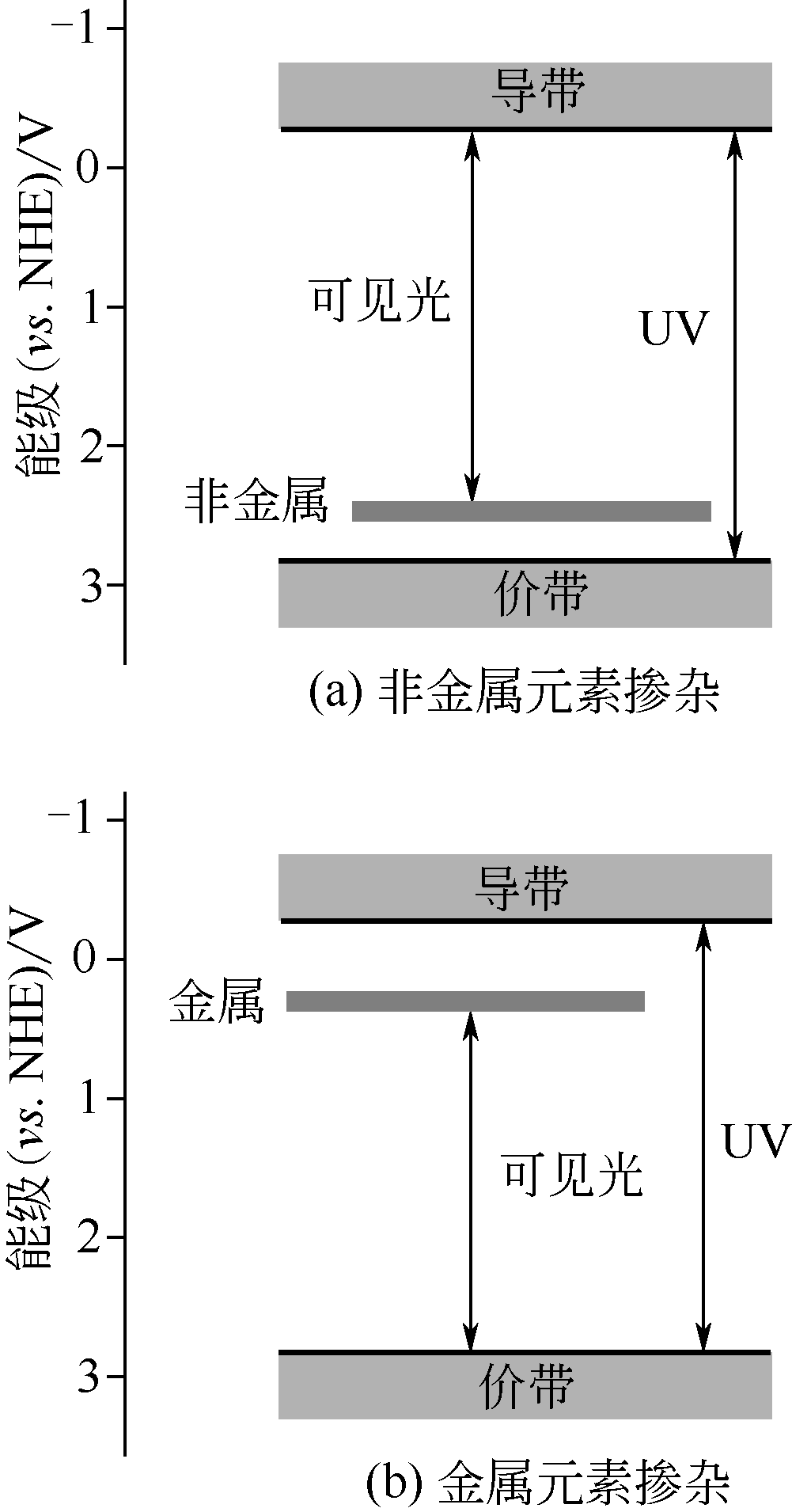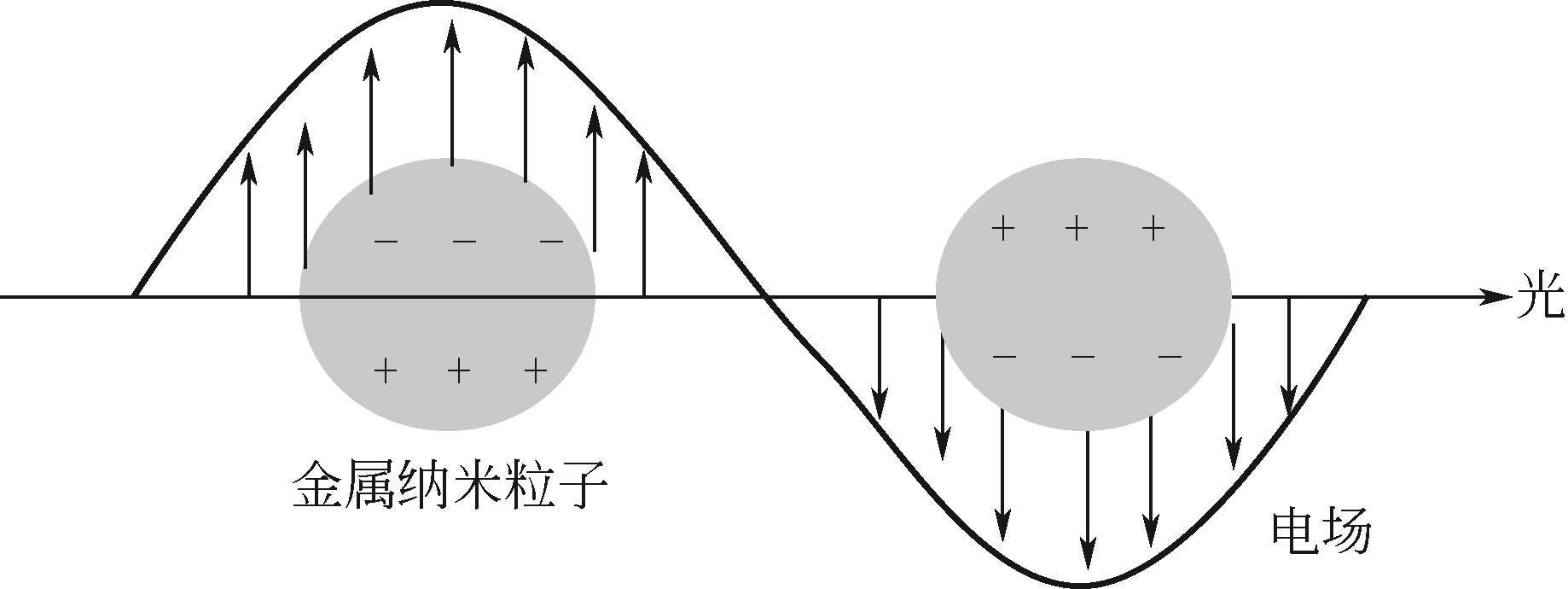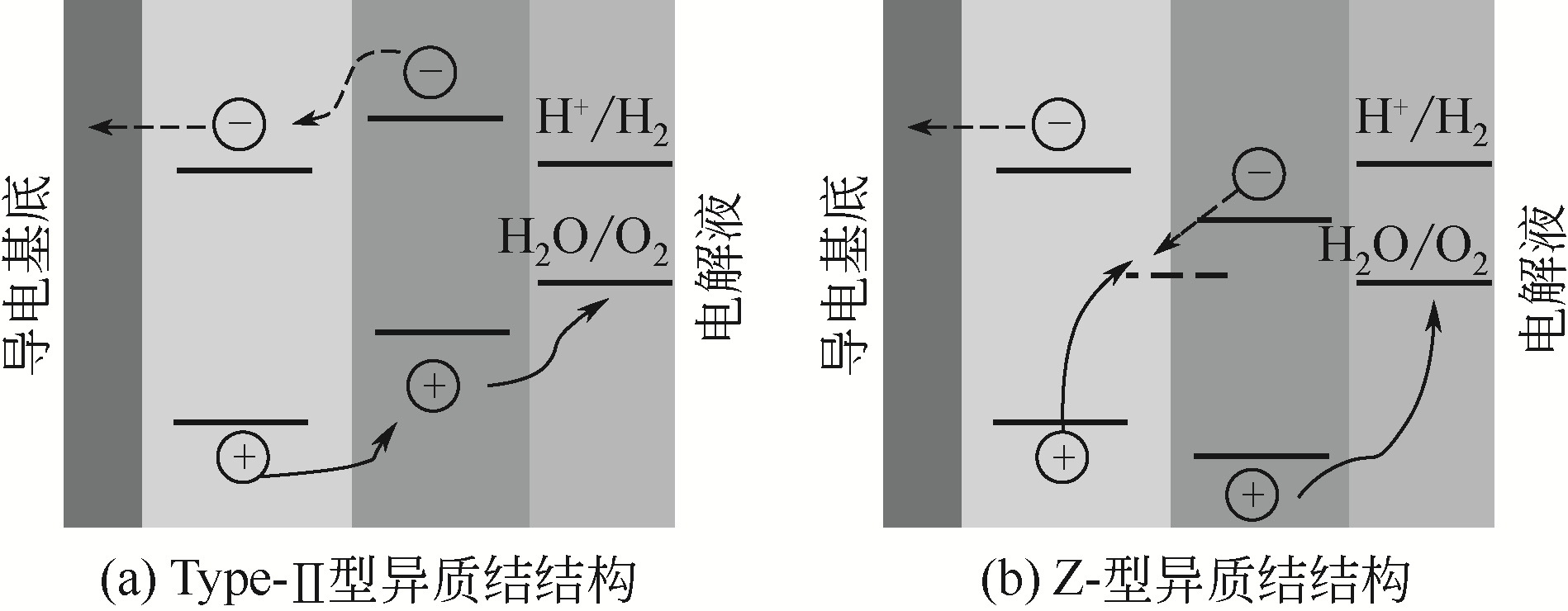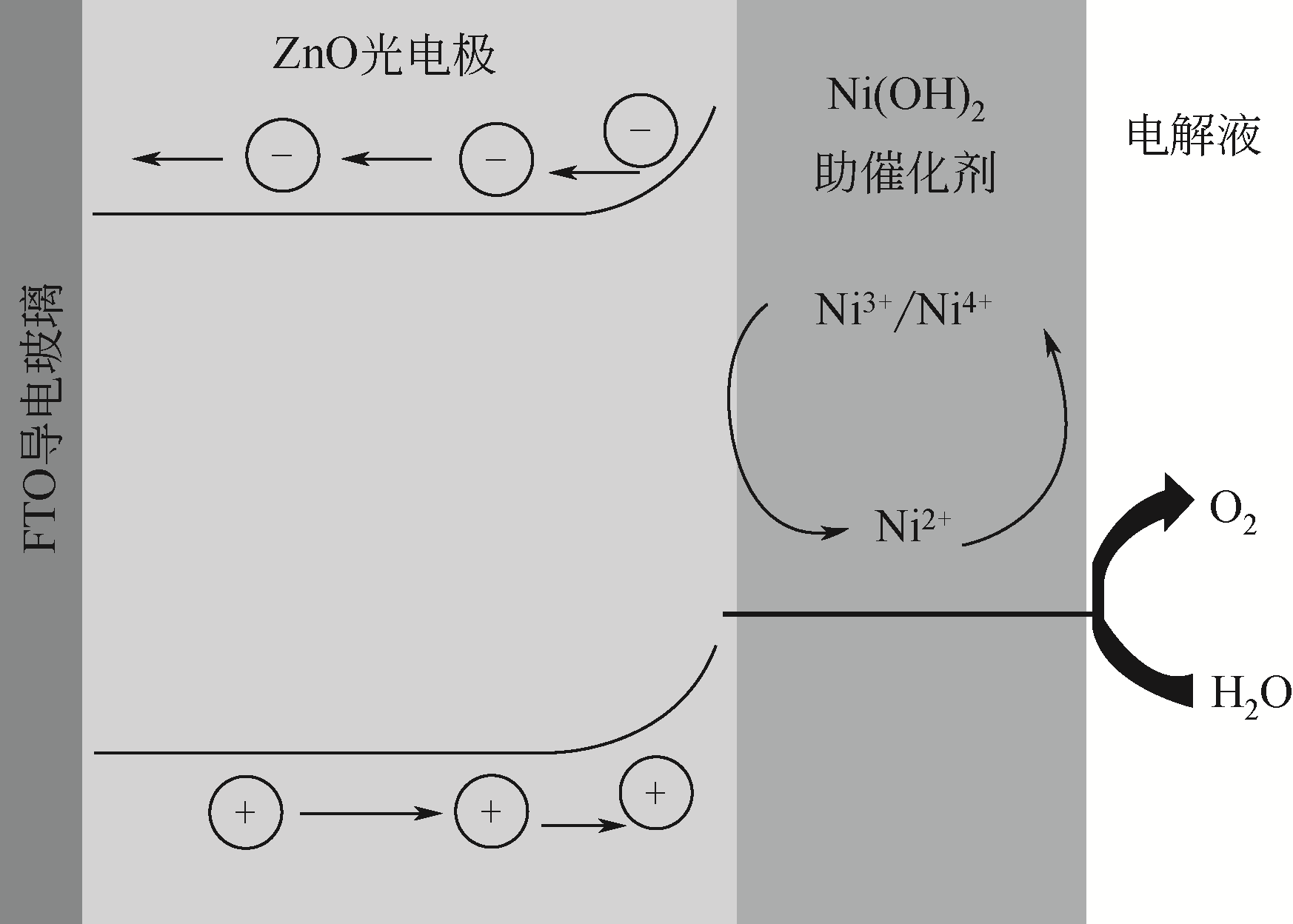Chemical Industry and Engineering Progress ›› 2021, Vol. 40 ›› Issue (3): 1413-1424.DOI: 10.16085/j.issn.1000-6613.2020-0845
• Industrial catalysis • Previous Articles Next Articles
Research progress of fabrication of ZnO-based photoanode and photoelectrocatalytic water splitting performances
FU Shurong1( ), ZHANG Qinsheng2, LU Jinzhi2, MA Zhanwei2
), ZHANG Qinsheng2, LU Jinzhi2, MA Zhanwei2
- 1.School of Bailie Mechanical Engineering, Lanzhou City University, Lanzhou 730070, Gansu, China
2.Lanzhou Institute of Chemical Physics, Chinese Academy of Sciences, Lanzhou 730000, Gansu, China
-
Received:2020-05-18Online:2021-03-17Published:2021-03-05 -
Contact:FU Shurong
ZnO基光电极的构筑及其光电催化水分解性能研究进展
- 1.兰州城市学院培黎机械工程学院,甘肃 兰州 730070
2.中国科学院兰州化学物理研究所,甘肃 兰州 730000
-
通讯作者:符淑瑢 -
作者简介:符淑瑢(1990—),女,博士,讲师,研究方向为光电催化。E-mail:shurongfu@126.com 。 -
基金资助:兰州城市学院博士科研启动基金(LZCU-BS2019-44)
CLC Number:
Cite this article
FU Shurong, ZHANG Qinsheng, LU Jinzhi, MA Zhanwei. Research progress of fabrication of ZnO-based photoanode and photoelectrocatalytic water splitting performances[J]. Chemical Industry and Engineering Progress, 2021, 40(3): 1413-1424.
符淑瑢, 张勤生, 鲁金芝, 马占伟. ZnO基光电极的构筑及其光电催化水分解性能研究进展[J]. 化工进展, 2021, 40(3): 1413-1424.
share this article
Add to citation manager EndNote|Ris|BibTeX
URL: https://hgjz.cip.com.cn/EN/10.16085/j.issn.1000-6613.2020-0845
| 1 | FUJISHIMA A, HONDA K. Electrochemical photolysis of water at a semiconductor electrode[J]. Nature, 1972, 238(5358): 37-38. |
| 2 | GOVATSI K, SEFERLIS A, NEOPHYTIDES S G, al et, Influence of the morphology of ZnO nanowires on the photoelectrochemical water splitting efficiency[J]. International Journal of Hydrogen Energy, 2018, 43(10): 4866-4879. |
| 3 | RANJITH K S, KUMAR R T R. Surfactant free, simple, morphological and defect engineered ZnO nanocatalyst: effective study on sunlight driven and reusable photocatalytic properties[J]. Journal of Photochemistry and Photobiology A: Chemistry, 2016, 329: 35-45. |
| 4 | GONZALEZ V I, LIRA C M. Vertically-aligned nanostructures of ZnO for excitonic solar cells: a review[J]. Energy & Environmental Science, 2009, 2(1): 19-34. |
| 5 | LI X B, NIU F J, SU J Z, et al. Photoelectrochemical performance dependence on geometric surface area of branched ZnO nanowires[J]. ChemElectroChem, 2018, 5(23): 3717-3722. |
| 6 | MARTINSON A B F, MCGARRAH J E, PARPIA M O K, et al. Dynamics of charge transport and recombination in ZnO nanorod array dye-sensitized solar cells[J]. Physical Chemistry Chemical Physics, 2006, 8(40): 4655-4659. |
| 7 | SUN X, LI Q, JIANG J, al et, Morphology-tunable synthesis of ZnO nanoforest and its photoelectrochemical performance[J]. Nanoscale, 2014, 6(15): 8769-8780. |
| 8 | ZHANG X, LIU Y, KANG Z. 3D Branched ZnO nanowire arrays decorated with plasmonic Au nanoparticles for high-performance photoelectrochemical water splitting[J]. ACS Applied Materials & Interfaces, 2014, 6(6): 4480-4489. |
| 9 | KO S H, LEE D, KANG H W, et al. Nanoforest of hydrothermally grown hierarchical ZnO nanowires for a high efficiency dye-sensitized solar cell[J]. Nano Letters, 2011, 11(2): 666-671. |
| 10 | HSU Y K, LIN Y G, CHEN Y C. Polarity-dependent photoelectrochemical activity in ZnO nanostructures for solar water splitting[J]. Electrochemistry Communications, 2011, 13(12): 1383-1386. |
| 11 | CHEN H, WEI Z, YAN K, et al. Epitaxial growth of ZnO nanodisks with large exposed polar facets on nanowire arrays for promoting photoelectrochemical water splitting[J]. Small, 2014, 10(22): 4760-4769. |
| 12 | LIU Q T, LIU D Y, LI J M, et al. The impact of crystal defects towards oxide semiconductor photoanode for photoelectrochemical water splitting[J]. Frontiers of Physics, 2019, 14(5): 53403. |
| 13 | FAWZY S M, OMAR M M, ALLAM N K. Photoelectrochemical water splitting by defects in nanostructured multinary transition metal oxides[J]. Solar Energy Materials and Solar Cells, 2019, 194: 184-194. |
| 14 | KRZYWIECKI M, GRZĄDZIEL L, SARFRAZ A, et al. Zinc oxide as a defect-dominated material in thin films for photovoltaic applications-experimental determination of defect levels, quantification of composition, and construction of band diagram[J]. Physical Chemistry Chemical Physics, 2015, 17(15): 10004-10013. |
| 15 | LU X, WANG G, XIE S, et al. Efficient photocatalytic hydrogen evolution over hydrogenated ZnO nanorod arrays[J]. Chemical Communications, 2012, 48(62): 7717-7719. |
| 16 | LI H, FU Y, LIU H, et al. Defect-controlled ZnO nanorod arrays for enhanced photoelectrochemical performance[J]. Inorganic Chemistry Communications, 2013, 30: 182-186. |
| 17 | COOPER J K, LING Y, LONGO C, et al. Effects of hydrogen treatment and air annealing on ultrafast charge carrier dynamics in ZnO nanowires under in situ photoelectrochemical conditions[J]. The Journal of Physical Chemistry C, 2012, 116(33): 17360-17368. |
| 18 | BABIKIER M, WANG D, WANG J, et al. Fabrication and properties of sulfur (S)-doped ZnO nanorods[J]. Journal of Materials Science: Materials in Electronics, 2014, 25(1): 157-162. |
| 19 | KHAN A, AHMED M I, ADAM A, et al. A novel fabrication methodology for sulfur-doped ZnO nanorods as an active photoanode for improved water oxidation in visible-light regime[J]. Nanotechnology, 2016, 28(5): 055602. |
| 20 | YANG X, WOLCOTT A, WANG G, et al. Nitrogen-doped ZnO nanowire arrays for photoelectrochemical water splitting[J]. Nano Letters, 2009, 9(6): 2331-2336. |
| 21 | WANG M, REN F, ZHOU J, et al. N Doping to ZnO nanorods for photoelectrochemical water splitting under visible light: engineered impurity distribution and terraced band structure[J]. Scientific Reports, 2015, 5(1): 12925. |
| 22 | BHIRUD A P, SATHAYE S D, WAICHAL R P, et al. An eco-friendly, highly stable and efficient nanostructured p-type N-doped ZnO photocatalyst for environmentally benign solar hydrogen production[J]. Green Chemistry, 2012, 14(10): 2790-2798. |
| 23 | 姚凯, 姜宏, 熊春荣. 碳掺杂ZnO薄膜及可见光催化氮合成氨[J]. 化工进展, 2019, 38(2): 913-920. |
| YAO K, JIANG H, XIONG C R. Carbon doped ZnO thin films for visible-light driven conversion of nitrogen to ammonia[J]. Chemical Industry and Engineering Progress, 2019, 38(2): 913-920. | |
| 24 | XIE S, LU X, ZHAI T, et al. Enhanced photoactivity and stability of carbon and nitrogen co-treated ZnO nanorod arrays for photoelectrochemical water splitting[J]. Journal of Materials Chemistry, 2012, 22(28): 14272-14275. |
| 25 | COMMANDEUR D, BROWN G, MCNULTY P, et al. Yttrium-doped ZnO nanorod arrays for increased charge mobility and carrier density for enhanced solar water splitting[J]. The Journal of Physical Chemistry C, 2019, 123(30): 18187-18197. |
| 26 | TYNELL T, KARPPINEN M. Atomic layer deposition of ZnO: a review[J]. Semiconductor Science and Technology, 2014, 29(4): 043001. |
| 27 | LIN Y G, HSU Y K, CHEN Y C, et al. Cobalt-phosphate-assisted photoelectrochemical water oxidation by arrays of molybdenum-doped zinc oxide nanorods[J]. ChemSusChem, 2014, 7(9): 2748-2754. |
| 28 | LI C, REN F, WANG M, et al. V ions implanted ZnO nanorod arrays for photoelectrochemical water splitting under visible light[J]. International Journal of Hydrogen Energy, 2015, 40(3): 1394-1401. |
| 29 | LIU Y, KANG Z, ZHANG S, et al. Ferroelectric polarization-enhanced charge separation in a vanadium-doped ZnO photoelectrochemical system[J]. Inorganic Chemistry Frontiers, 2018, 5(7): 1533-1539. |
| 30 | LEE W C, CANCIANI G E, ALWHSHE B O S, et al. Enhanced photoelectrochemical water oxidation by ZnxMyO (M = Ni, Co, K, Na) nanorod arrays[J]. International Journal of Hydrogen Energy, 2016, 41(1): 123-131. |
| 31 | YANG Z, WANG Y, ZHANG D. A novel signal-on photoelectrochemical sensing platform based on biosynthesis of CdS quantum dots sensitizing ZnO nanorod arrays[J]. Sensors and Actuators B: Chemical, 2018, 261: 515-521. |
| 32 | LEE W, MIN S K, DHAS V, et al. Chemical bath deposition of CdS quantum dots on vertically aligned ZnO nanorods for quantum dots-sensitized solar cells[J]. Electrochemistry Communications, 2009, 11(1): 103-106. |
| 33 | JEAN J, CHANG S, BROWN P R, et al. ZnO nanowire arrays for enhanced photocurrent in PbS quantum dot solar cells[J]. Advanced Materials, 2013, 25(20): 2790-2796. |
| 34 | CHEN H M, CHEN C K, CHANG Y C, et al. Quantum dot monolayer sensitized ZnO nanowire-array photoelectrodes: true efficiency for water splitting[J]. Angewandte Chemie: International Edition, 2010, 122(34): 6102-6105. |
| 35 | GUO C X, DONG Y, YANG H B, et al. Graphene quantum dots as a green sensitizer to functionalize ZnO nanowire arrays on F-doped SnO2 glass for enhanced photoelectrochemical water splitting[J]. Advanced Energy Materials, 2013, 3(8): 997-1003. |
| 36 | CHEN C K, SHEN Y P, CHEN H M, et al. Quantum-dot-sensitized nitrogen-doped ZnO for efficient photoelectrochemical water splitting[J]. European Journal of Inorganic Chemistry, 2014, 2014(4): 773-779. |
| 37 | WANG G, YANG X, QIAN F, et al. Double-sided CdS and CdSe quantum dot co-sensitized ZnO nanowire arrays for photoelectrochemical hydrogen generation[J]. Nano Letters, 2010, 10(3): 1088-1092. |
| 38 | ZHOU X, LIU G, YU J, et al. Surface plasmon resonance-mediated photocatalysis by noble metal-based composites under visible light[J]. Journal of Materials Chemistry, 2012, 22(40): 21337-21354. |
| 39 | JIANG R, LI B, FANG C, et al. Metal/semiconductor hybrid nanostructures for plasmon-enhanced applications[J]. Advanced Materials, 2014, 26(31): 5274-5309. |
| 40 | LINIC S, CHRISTOPHER P, INGRAM D B. Plasmonic-metal nanostructures for efficient conversion of solar to chemical energy[J]. Nature Materials, 2011, 10(12): 911-921. |
| 41 | WEI Y, KE L, KONG J, et al. Enhanced photoelectrochemical water-splitting effect with a bent ZnO nanorod photoanode decorated with Ag nanoparticles[J]. Nanotechnology, 2012, 23(23): 235401. |
| 42 | WEI Y, KONG J, YANG L, et al. Polydopamine-assisted decoration of ZnO nanorods with Ag nanoparticles: an improved photoelectrochemical anode[J]. Journal of Materials Chemistry A, 2013, 1(16): 5045-5052. |
| 43 | KANG Z, YAN X, WANG Y, et al. Self-powered photoelectrochemical biosensing platform based on Au NPs@ZnO nanorods array[J]. Nano Research, 2016, 9(2): 344-352. |
| 44 | WU M, CHEN W J, SHEN Y H, et al. In situ growth of matchlike ZnO/Au plasmonic heterostructure for enhanced photoelectrochemical water splitting[J]. ACS Applied Materials & Interfaces, 2014, 6(17): 15052-15060. |
| 45 | CHIKATE P R, DAWARE K D, PATIL S S, et al. Effects of Au loading on the enhancement of photoelectrochemical activities of the Au@ZnO nano-heteroarchitecture[J]. New Journal of Chemistry, 2020, 44(14): 5535-5544. |
| 46 | WANG T, JIAO Z, CHEN T, et al. Vertically aligned ZnO nanowire arrays tip-grafted with silver nanoparticles for photoelectrochemical applications[J]. Nanoscale, 2013, 5(16): 7552-7557. |
| 47 | WANG T, JIN B, JIAO Z, et al. Photo-directed growth of Au nanowires on ZnO arrays for enhancing photoelectrochemical performances[J]. Journal of Materials Chemistry A, 2014, 2(37): 15553-15559. |
| 48 | FU S, ZHANG B, HU H, et al. ZnO nanowire arrays decorated with PtO nanowires for efficient solar water splitting[J]. Catalysis Science & Technology, 2018, 8(11): 2789-2793. |
| 49 | TAK Y, HONG S J, LEE J S, et al. Fabrication of ZnO/CdS core/shell nanowire arrays for efficient solar energy conversion[J]. Journal of Materials Chemistry, 2009, 19(33): 5945-5951. |
| 50 | LI Y, LIU Z, WANG Y, et al. ZnO/CuInS2 core/shell heterojunction nanoarray for photoelectrochemical water splitting[J]. International Journal of Hydrogen Energy, 2012, 37(20): 15029-15037. |
| 51 | LIU C, MENG F L, ZHANG L, et al. CuO/ZnO heterojunction nanoarrays for enhanced photoelectrochemical water oxidation[J]. Applied Surface Science, 2019, 469: 276-282. |
| 52 | CAO S, YAN X, KANG Z, et al. Band alignment engineering for improved performance and stability of ZnFe2O4 modified CdS/ZnO nanostructured photoanode for PEC water splitting[J]. Nano Energy, 2016, 24: 25-31. |
| 53 | ZHAO K, YAN X, GU Y, et al. Self-powered photoelectrochemical biosensor based on CdS/RGO/ZnO nanowire array heterostructure[J]. Small, 2016, 12(2): 245-251. |
| 54 | HIEU H N, NGHIA N V, VUONG N M, et al. Omnidirectional Au-embedded ZnO/CdS core/shell nanorods for enhanced photoelectrochemical water-splitting efficiency[J]. Chemical Communications, 2020, 56(28): 3975-3978. |
| 55 | CHEN Y, WANG L, GAO R, et al. Polarization-enhanced direct Z-scheme ZnO-WO3-x nanorod arrays for efficient piezoelectric-photoelectrochemical water splitting[J]. Applied Catalysis B: Environmental, 2019, 259: 118079. |
| 56 | FU S, HU H, FENG C, et al. Epitaxial growth of ZnWO4 hole-storage nanolayers on ZnO photoanodes for efficient solar water splitting[J]. Journal of Materials Chemistry A, 2019, 7(6): 2513-2517. |
| 57 | TAN C, CHEN J, WU X J, et al. Epitaxial growth of hybrid nanostructures[J]. Nature Reviews Materials, 2018, 3(2): 17089. |
| 58 | ZHOU T, WANG J, CHEN S, et al. Bird-nest structured ZnO/TiO2 as a direct Z-scheme photoanode with enhanced light harvesting and carriers kinetics for highly efficient and stable photoelectrochemical water splitting[J]. Applied Catalysis B: Environmental, 2020, 267: 118599. |
| 59 | WANG Q, HISATOMI T, JIA Q, et al. Scalable water splitting on particulate photocatalyst sheets with a solar-to-hydrogen energy conversion efficiency exceeding 1%[J]. Nature Materials, 2016, 15(6): 611-615. |
| 60 | YU Z B, XIE Y P, LIU G, et al. Self-assembled CdS/Au/ZnO heterostructure induced by surface polar charges for efficient photocatalytic hydrogen evolution[J]. Journal of Materials Chemistry A, 2013, 1(8): 2773-2776. |
| 61 | YANG X, LI H, ZHANG W, et al. High visible photoelectrochemical activity of Ag nanoparticle-sandwiched CdS/Ag/ZnO nanorods[J]. ACS Applied Materials & Interfaces, 2017, 9(1): 658-667. |
| 62 | GUPTA R, ESWAR N K, MODAK J M, et al. Effect of morphology of zinc oxide in ZnO-CdS-Ag ternary nanocomposite towards photocatalytic inactivation of E. coli under UV and visible light[J]. Chemical Engineering Journal, 2017, 307: 966-980. |
| 63 | LINGAMPALLI S R, GAUTAM U K, RAO C N R. Highly efficient photocatalytic hydrogen generation by solution-processed ZnO/Pt/CdS, ZnO/Pt/Cd1-xZnxS and ZnO/Pt/CdS1-xSex hybrid nanostructures[J]. Energy & Environmental Science, 2013, 6(12): 3589-3594. |
| 64 | KIM Y, SHIN D, CHANG W J, et al. Hybrid Z-scheme using photosystem I and BiVO4 for hydrogen production[J]. Advanced Functional Materials, 2015, 25(16): 2369-2377. |
| 65 | WEN P, SUN Y, LI H, et al. A highly active three-dimensional Z-scheme ZnO/Au/g-C3N4 photocathode for efficient photoelectrochemical water splitting[J]. Applied Catalysis B: Environmental, 2020, 263: 118180. |
| 66 | ZHAN F, YANG Y, LIU W, et al. Facile synthesis of FeOOH quantum dots modified ZnO nanorods films via a metal-solating process[J]. ACS Sustainable Chemistry & Engineering, 2018, 6(6): 7789-7798. |
| 67 | MAO Y, YANG H, CHEN J, et al. Significant performance enhancement of ZnO photoanodes from Ni(OH)2 electrocatalyst nanosheets overcoating[J]. Nano Energy, 2014, 6: 10-18. |
| 68 | MAO Y, CHENG Y, WANG J, et al. Amorphous NiO electrocatalyst overcoated ZnO nanorod photoanodes for enhanced photoelectrochemical performance[J]. New Journal of Chemistry, 2016, 40(1): 107-112. |
| 69 | DING C, SHI J, WANG Z, et al. Photoelectrocatalytic water splitting: significance of cocatalysts, electrolyte, and interfaces[J]. ACS Catalysis, 2017, 7(1): 675-688. |
| 70 | SHE H, YUE P, HUANG J, et al. One-step hydrothermal deposition of F:FeOOH onto BiVO4 photoanode for enhanced water oxidation[J]. Chemical Engineering Journal, 2020, 392: 123703. |
| 71 | XU D, XIA T, FAN W, et al. MOF-derived Co3O4 thin film decorated BiVO4 for enhancement of photoelectrochemical water splitting[J]. Applied Surface Science, 2019, 491: 497-504. |
| 72 | LIU C, XU Y, LUO H, et al. Synthesis and photoelectrochemical properties of CoOOH/phosphorus-doped hematite photoanodes for solar water oxidation[J]. Chemical Engineering Journal, 2019, 363: 23-32. |
| 73 | KIM M-W, JOSHI B, SAMUEL E, et al. Electrosprayed MnO2 on ZnO nanorods with atomic layer deposited TiO2 layer for photoelectrocatalytic water splitting[J]. Applied Catalysis B: Environmental, 2020, 271: 118928. |
| 74 | HAYDOUS F, SI W, GUZENKO V A, et al. Improved photoelectrochemical water splitting of CaNbO2N photoanodes by CoPi photodeposition and surface passivation[J]. The Journal of Physical Chemistry C, 2019, 123(2): 1059-1068. |
| 75 | LIU G, SHI J, ZHANG F, et al. A tantalum nitride photoanode modified with a hole-storage layer for highly stable solar water splitting[J]. Angewandte Chemie: International Edition, 2014, 53(28): 7295-7299. |
| 76 | MA Z, THERSLEFF T, GORNE A L, et al. Quaternary core-shell oxynitride nanowire photoanode containing a hole-extraction gradient for photoelectrochemical water oxidation[J]. ACS Applied Materials & Interfaces, 2019, 11(21): 19077-19086. |
| [1] | ZHANG Mingyan, LIU Yan, ZHANG Xueting, LIU Yake, LI Congju, ZHANG Xiuling. Research progress of non-noble metal bifunctional catalysts in zinc-air batteries [J]. Chemical Industry and Engineering Progress, 2023, 42(S1): 276-286. |
| [2] | SHI Yongxing, LIN Gang, SUN Xiaohang, JIANG Weigeng, QIAO Dawei, YAN Binhang. Research progress on active sites in Cu-based catalysts for CO2 hydrogenation to methanol [J]. Chemical Industry and Engineering Progress, 2023, 42(S1): 287-298. |
| [3] | XIE Luyao, CHEN Songzhe, WANG Laijun, ZHANG Ping. Platinum-based catalysts for SO2 depolarized electrolysis [J]. Chemical Industry and Engineering Progress, 2023, 42(S1): 299-309. |
| [4] | YANG Xiazhen, PENG Yifan, LIU Huazhang, HUO Chao. Regulation of active phase of fused iron catalyst and its catalytic performance of Fischer-Tropsch synthesis [J]. Chemical Industry and Engineering Progress, 2023, 42(S1): 310-318. |
| [5] | HU Xi, WANG Mingshan, LI Enzhi, HUANG Siming, CHEN Junchen, GUO Bingshu, YU Bo, MA Zhiyuan, LI Xing. Research progress on preparation and sodium storage properties of tungsten disulfide composites [J]. Chemical Industry and Engineering Progress, 2023, 42(S1): 344-355. |
| [6] | XU Chunshu, YAO Qingda, LIANG Yongxian, ZHOU Hualong. Research progress on functionalization strategies of covalent organic frame materials and its adsorption properties for Hg(Ⅱ) and Cr(Ⅵ) [J]. Chemical Industry and Engineering Progress, 2023, 42(S1): 461-478. |
| [7] | WANG Lele, YANG Wanrong, YAO Yan, LIU Tao, HE Chuan, LIU Xiao, SU Sheng, KONG Fanhai, ZHU Canghai, XIANG Jun. Influence of spent SCR catalyst blending on the characteristics and deNO x performance for new SCR catalyst [J]. Chemical Industry and Engineering Progress, 2023, 42(S1): 489-497. |
| [8] | DENG Liping, SHI Haoyu, LIU Xiaolong, CHEN Yaoji, YAN Jingying. Non-noble metal modified vanadium titanium-based catalyst for NH3-SCR denitrification simultaneous control VOCs [J]. Chemical Industry and Engineering Progress, 2023, 42(S1): 542-548. |
| [9] | CHENG Tao, CUI Ruili, SONG Junnan, ZHANG Tianqi, ZHANG Yunhe, LIANG Shijie, PU Shi. Analysis of impurity deposition and pressure drop increase mechanisms in residue hydrotreating unit [J]. Chemical Industry and Engineering Progress, 2023, 42(9): 4616-4627. |
| [10] | WANG Peng, SHI Huibing, ZHAO Deming, FENG Baolin, CHEN Qian, YANG Da. Recent advances on transition metal catalyzed carbonylation of chlorinated compounds [J]. Chemical Industry and Engineering Progress, 2023, 42(9): 4649-4666. |
| [11] | ZHANG Qi, ZHAO Hong, RONG Junfeng. Research progress of anti-toxicity electrocatalysts for oxygen reduction reaction in PEMFC [J]. Chemical Industry and Engineering Progress, 2023, 42(9): 4677-4691. |
| [12] | GE Quanqian, XU Mai, LIANG Xian, WANG Fengwu. Research progress on the application of MOFs in photoelectrocatalysis [J]. Chemical Industry and Engineering Progress, 2023, 42(9): 4692-4705. |
| [13] | WANG Weitao, BAO Tingyu, JIANG Xulu, HE Zhenhong, WANG Kuan, YANG Yang, LIU Zhaotie. Oxidation of benzene to phenol over aldehyde-ketone resin based metal-free catalyst [J]. Chemical Industry and Engineering Progress, 2023, 42(9): 4706-4715. |
| [14] | GE Yafen, SUN Yu, XIAO Peng, LIU Qi, LIU Bo, SUN Chengying, GONG Yanjun. Research progress of zeolite for VOCs removal [J]. Chemical Industry and Engineering Progress, 2023, 42(9): 4716-4730. |
| [15] | WU Haibo, WANG Xilun, FANG Yanxiong, JI Hongbing. Progress of the development and application of 3D printing catalyst [J]. Chemical Industry and Engineering Progress, 2023, 42(8): 3956-3964. |
| Viewed | ||||||
|
Full text |
|
|||||
|
Abstract |
|
|||||











